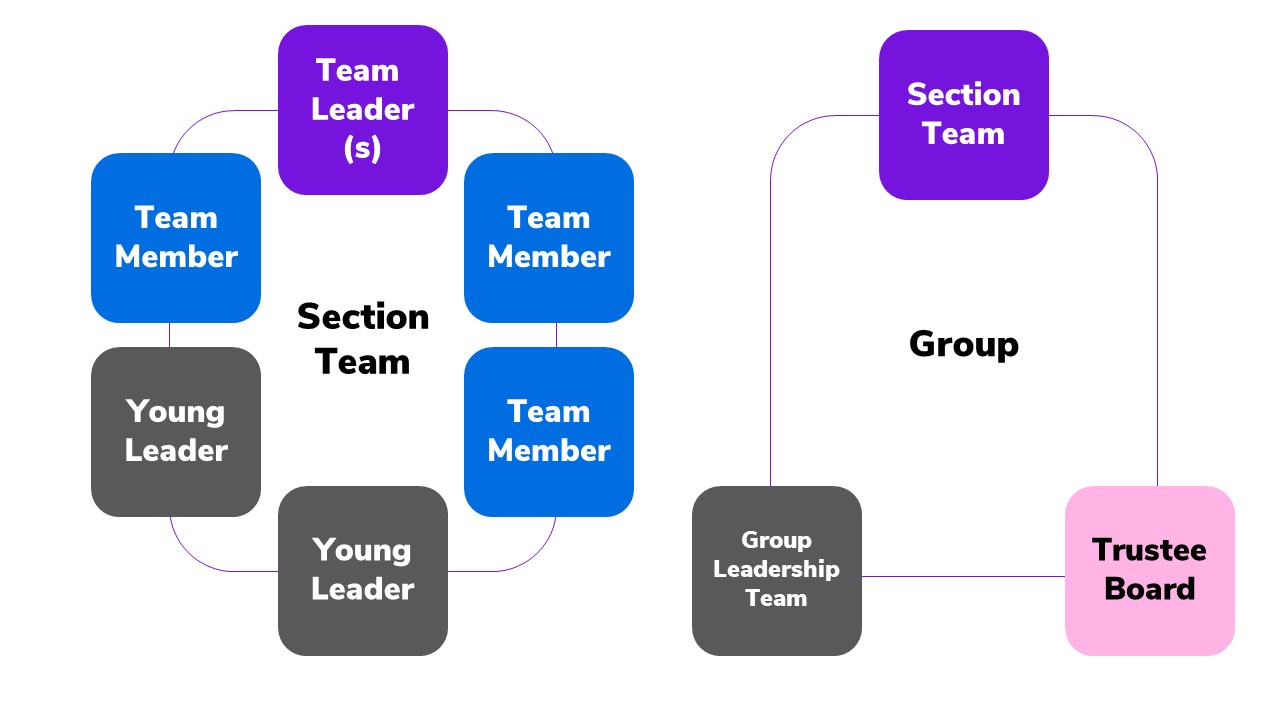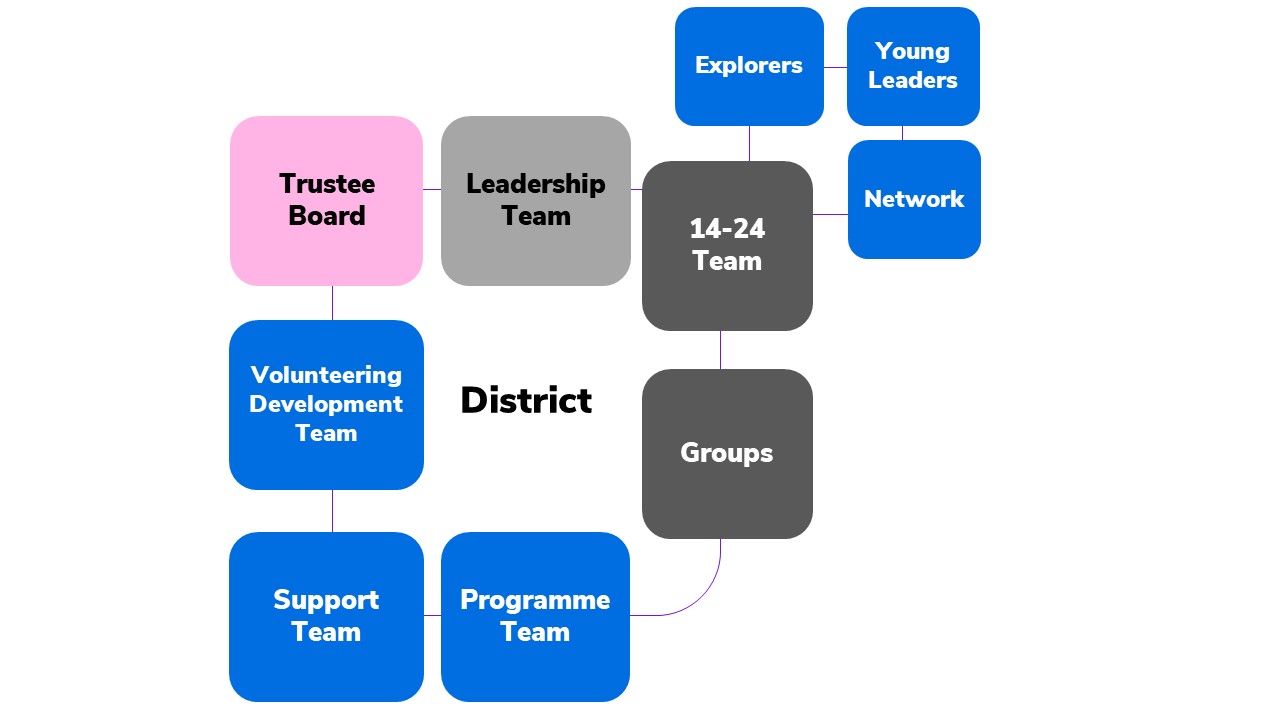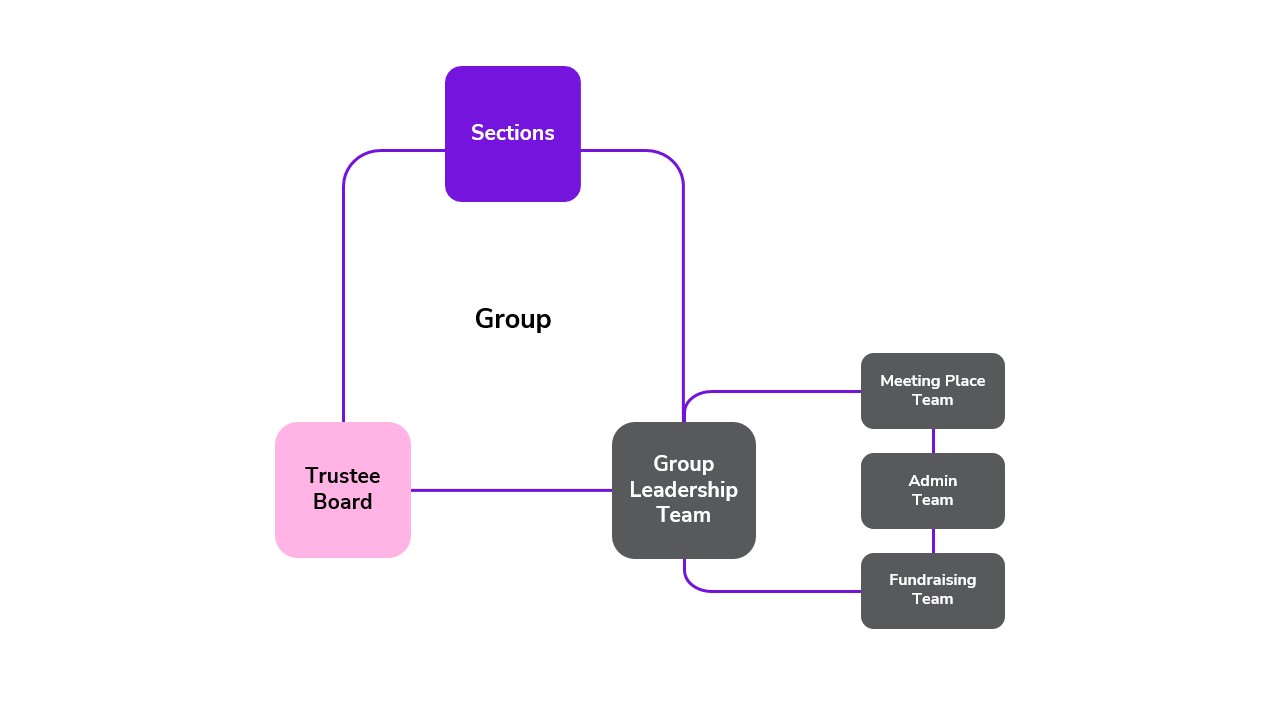Structure of our volunteer teams
Discover how we organise our volunteer teams and sub-teams within Sections, Groups, Districts and Counties
How we organise Sections and Groups
Sections run the programme. They’re at the heart of Scouts’ work with young people and are supported by people outside of Scouts, who informally help run part of the programme.
Scout Groups help volunteers work well together and keep them feeling motivated across Squirrel, Beaver, Cub, and Scout Sections. They make sure the Group is respected and supported in their local community.
In each Scout Group, there are three types of teams:
- Section Teams run high-quality programmes safely
- The Group Leadership Team helps all volunteers in the Group (including Young Leaders) work together to plan and run high-quality programmes
- The Group Trustee Board provides charity governance
How we organise Districts
Scout Districts help volunteers develop, improve Section programmes, and support Scouts to run in the best way possible.
They keep volunteers working well together and feeling motivated. They also make sure the 14-24 Sections are working well and are well regarded in their local community.
The District Leadership Team is made up of:
- District Lead Volunteers
- Team Leaders of each District Team
- Lead Volunteers of each Group in the District
- District Youth Leads
- Other Leadership Team Members who may have specific responsibilities
Each District has a:
- Leadership Team
- 14–24 Team
- Programme Team
- Volunteering Development Team
- Support Team
- Trustee Board
Multiple Districts can share some functions or teams. In this case, the District Leadership Teams will make sure the teams are meeting their own District’s needs.
How we organise Counties
Scout Counties help volunteers in County teams (including District Lead Volunteers) develop, and they enhance Section programmes with opportunities that are best run at County scale.
The County Leadership Team is made up of:
- County Lead Volunteers
- Team Leaders of each County team
- County Youth Leads
- Lead Volunteers of each District
- Other Leadership Team Members who may have specific responsibilities
Each County has a:
- Leadership Team
- Programme Team
- Volunteering Development Team
- Support Team
- Trustee Board
Multiple Counties can share functions or teams. In this case, the County Leadership Teams need to make sure teams meet their County’s needs.
Sub-teams
Some teams are quite large, with multiple volunteers doing similar tasks. In these cases, it might be helpful to use sub-teams.
Sub-teams are smaller groups of volunteers with a specific area of focus, sitting within a larger team. For example:
- A Fundraising Team within a Group Leadership Team
- A Hillwalking Team within the Programme Team
All teams (except Section Teams) can have their own sub-teams. Scout Active Support Units may also become sub-teams.
You can share sub-teams across Districts or Counties. And you can decide locally if sub-teams are needed, and what they’re called.
Sub-teams are optional and can be set-up at any time by the main team. But it's a good idea to start thinking now about whether sub-teams might be useful in your local area, and who might be in them.
We can use sub-teams to:
- Increase a sense of identity and belonging within our volunteers.
- Make better use of our volunteers' time and resources.
- Help make it clearer what people do and what they’re responsible for.
- Make it easier to find and reach the right people on our digital system. For example, a Cub Section Team Member can find out who the District Hillwalking Team Leader is.
Sub-team examples for Groups
Here's an example of what a group might look like with sub-teams added within the Group Leadership Team:
In this example, the Group Leadership Team has delegated some support and operational tasks to volunteers in sub-teams:
- Meeting Place Team - looking after the Group's meeting place and camping equipment.
- Admin Team - overseeing day-to-day finances, communications, and supporting with member administration so that young people and adults can move seamlessly through the Group.
- Fundraising Team - engaging with the community, working with local businesses and other charities to secure fundraising and make the most of fundraising opportunities.
The Group Leadership Team remains overall responsible for the tasks that they delegate to the sub-teams, and they also carry out the remaining tasks on their team description.
Groups may choose not to set up sub-teams. This could be because they're a smaller group that has fewer volunteers, or they may not have the need for specific tasks. For example, if they rent their building they may not need to carry out meeting place maintenance.
Sub-team examples for Districts and Counties
Here are some examples of sub-teams that may be useful in your District or County:
- Adventurous Activities Teams - Climbing, Paddle Sports, Hillwalking, Shooting, Archery.
- Nights Away Team - helping our volunteers introduce Nights Away into their Section's programme, including assistance in gaining their permits.
- Top Awards Team - supporting volunteers with any programme changes, such as new badges and activities, to help young people achieve Top Awards.
- International Team - organising trips and activities.
- Events Team – taking the lead in organising a large event.
- Local programme delivery sub-teams - such as the Hospital Scouting Team, and the Section Badge Delivery Team.
- Awards and Recognition Team - working to recognise and appreciate our volunteers for their brilliant work.
- Learning Team - helping our volunteers with their learning.
- Growth and New Provision Team - helping Scouts to grow locally.
- Communications Team - working to engage with local media.
- Community Engagement Team - cultivating our relationships with other organisations.
- Property and Equipment Team - checking bookings and ongoing maintenance.
- IT and Digital Team - supporting IT, website, social media, email and technical aspects of wider communications




